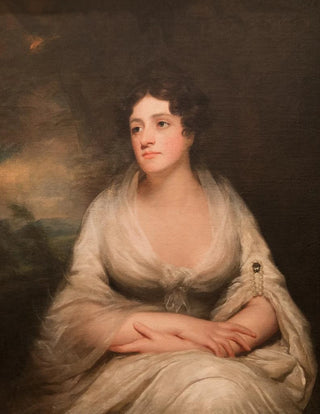Art print | Penelope Macdonald Hamilton Lady Belhaven et Stenton circa 1773-1816 - Sir Henry Raeburn


View from behind

Frame (optional)
Penelope Macdonald Hamilton Lady Belhaven and Stenton art print circa 1773-1816 - Sir Henry Raeburn – Captivating introduction
In the rich and fascinating world of 18th-century British painting, the "Penelope Macdonald Hamilton Lady Belhaven and Stenton" art print by Sir Henry Raeburn stands out for its elegance and depth. Created between 1773 and 1816, this depiction of an iconic female figure of her time invites us to explore the intimacy of a Scottish aristocrat. The artwork not only evokes the physical beauty of its subject but also the complexity of social relationships and gender roles of her era. Contemplating this portrait, the viewer is transported to a world where art and society intersect, revealing the subtleties of a bygone age.
Style and uniqueness of the work
Raeburn's technical mastery is particularly evident in this portrait, where light and shadow play a crucial role in accentuating Lady Belhaven's delicate features. The choice of colors, both vivid and nuanced, gives the piece a warm yet sophisticated atmosphere. The drapery of the protagonist's dress, carefully rendered, demonstrates exceptional craftsmanship, while her direct and engaging gaze creates an immediate connection with the viewer. Raeburn succeeds in capturing not only the physical appearance of his model but also an essence, a personality that transcends the simple portrait. In this way, this work stands out for its psychological approach, revealing the emotions and thoughts that inhabit Lady Belhaven, while offering a reflection on social status and the expectations of her time.
The artist and his influence
Sir Henry Raeburn, an emblematic figure of Scottish painting, made his mark with a unique style that combines realism and romanticism. Born in 1756, he evolved within a rapidly changing artistic context, where neoclassical and romantic influences intertwined. Raeburn was one of the first artists to focus on portraits, capturing not only the appearance of his models but also their character and essence. His innovative approach influenced many contemporary and future artists, who saw in

Matte finish

View from behind

Frame (optional)
Penelope Macdonald Hamilton Lady Belhaven and Stenton art print circa 1773-1816 - Sir Henry Raeburn – Captivating introduction
In the rich and fascinating world of 18th-century British painting, the "Penelope Macdonald Hamilton Lady Belhaven and Stenton" art print by Sir Henry Raeburn stands out for its elegance and depth. Created between 1773 and 1816, this depiction of an iconic female figure of her time invites us to explore the intimacy of a Scottish aristocrat. The artwork not only evokes the physical beauty of its subject but also the complexity of social relationships and gender roles of her era. Contemplating this portrait, the viewer is transported to a world where art and society intersect, revealing the subtleties of a bygone age.
Style and uniqueness of the work
Raeburn's technical mastery is particularly evident in this portrait, where light and shadow play a crucial role in accentuating Lady Belhaven's delicate features. The choice of colors, both vivid and nuanced, gives the piece a warm yet sophisticated atmosphere. The drapery of the protagonist's dress, carefully rendered, demonstrates exceptional craftsmanship, while her direct and engaging gaze creates an immediate connection with the viewer. Raeburn succeeds in capturing not only the physical appearance of his model but also an essence, a personality that transcends the simple portrait. In this way, this work stands out for its psychological approach, revealing the emotions and thoughts that inhabit Lady Belhaven, while offering a reflection on social status and the expectations of her time.
The artist and his influence
Sir Henry Raeburn, an emblematic figure of Scottish painting, made his mark with a unique style that combines realism and romanticism. Born in 1756, he evolved within a rapidly changing artistic context, where neoclassical and romantic influences intertwined. Raeburn was one of the first artists to focus on portraits, capturing not only the appearance of his models but also their character and essence. His innovative approach influenced many contemporary and future artists, who saw in






